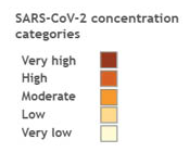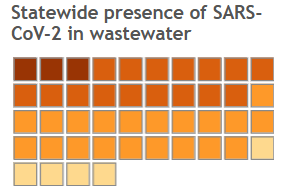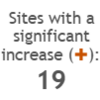Wastewater Monitoring: COVID-19 Levels in Wastewater
On this page you will find current and previous levels of SARS-CoV-2, the virus that causes COVID-19, in untreated wastewater across the state of Wisconsin. The data on this page will be updated at least twice per week. Note: There may be delays in updating due to holiday schedules and staff capacity.
For additional information about COVID-19 variant tracking conducted in Wisconsin wastewater, visit Wisconsin State Laboratory of Hygiene's SARS-CoV-2 Wastewater Genomic Dashboard.
This interactive dashboard includes the following sections:
| Data Description | Data Image |
|---|---|
| A legend with concentration levels categorized by color. See definition and methods below for more information. | |
| A chart showing the number of sewersheds within each concentration category. | |
| A summary of the number of sewersheds that have had a significant increase within the latest week of their sampling. | |
| A graph showing average SARS-CoV-2 levels across all participating sewersheds statewide. | |
| A summary of each sewershed’s virus levels by category and trajectory. | |
| Concentrations of SARS-CoV-2 virus gene copies in the wastewater of the selected sewershed, normalized by sewage flow and sewershed population. | |
| This map of Wisconsin shows the location of the selected sewershed and the most recent concentration category tested for that location. |
Sewershed:
An area of land where raw sewage from homes and businesses flows through a series of sewer pipes into a single downstream point, where it enters a wastewater treatment facility. The terms sewershed and location are used interchangeably on the wastewater pages with a given sewershed representing a location.
Processing time:
Dates on the graph indicate the day that the sample was collected at the treatment plant. With shipping and processing time, it typically takes five to 10 days for data to be included on the dashboard. The statewide average also has a 5-10 day lag to allow data to be received from sites. The statewide average concentration is not final until all data are received (indicated by grey area labeled “preliminary data”).
Category:
The colored circles on the dashboard (SARS-CoV-2 concentration categories) show the category of SARS-CoV-2 levels in each location (very low to very high). Categories are calculated by averaging the SARS-CoV-2 concentrations of the three most recent samples at a given facility, and comparing this current level to past levels measured at that facility. Levels are sorted into five categories: very low, low, moderate, high and very high.
- Highest 20% (very high)
- 60th - 80th percentile (high)
- 40th - 60th percentile (moderate)
- 20th - 40th percentile (low)
- Lowest 20% (very low)
The current category displayed on the dashboard for each site indicates how recent levels at that facility compare to the historical range of concentrations from that facility.
The length of the reference period used to determine the cut-off levels for each category depends on the laboratory method used and how long the facility has been submitting samples. The start of the reference period will be indicated by a vertical line on the graph for each facility, and will be fixed to the specific date when current methods were implemented.
Trajectory:
Significant increases in SARS-CoV-2 levels in wastewater are defined when recent measurements show an increasing trend and new values are higher than recent measurements. Increasing trends are determined from a linear regression over the past five measurements. A high measurement is defined if the average of the three most recent data points is above the 80th percentile of all data from the past 30 days.
An increase in virus gene copies over time shows that cases may be increasing in the location. Because each community is different, you should not compare viral gene copy numbers between locations. Looking at trends over time in a specific location can be used to help understand whether cases or hospitalizations are likely to increase in the future.
Scale:
The wastewater concentration of SARS-CoV-2 figure can now be viewed with a linear or a logarithmic (log) scale. These two options are displaying the same values, but with different scales on the y-axis of the figure.
A linear scale can be most helpful when data points are in a narrow range and there isn't much variability between them.
A log scale can be most helpful when there is a large range of values in the data. Because there is a large range of values in the wastewater data, a log scale may be more helpful to see trends over time in certain sewersheds.
Statewide Average:
The statewide average concentration (orange line) represents SARS-CoV-2 levels across all sites in Wisconsin over the past seven days. This is calculated as the average amount of SARS-CoV-2 virus in the wastewater among participating sites, displayed on the graphs as millions of gene copies per person per day. Individual sites may have levels and trends that are different from the statewide average, so click on your local sewershed for a detailed view.
The statewide average is calculated with the following formula:
- For each site, we calculate the average SARS-CoV-2 concentration over the past seven days. This one-week average uses a rolling geometric mean of all samples at that site from the past seven days normalized to the flow rate and population size of the sewershed.
- Before averaging across sites, concentrations submitted by UW-Milwaukee laboratory are multiplied by a fixed amount to account for known differences in laboratory methods between that lab and other labs.
- A statewide average for each day is then calculated using the geometric mean of all sites combined.
- The daily statewide average is smoothed with a seven-day rolling average (arithmetic mean).
- The statewide average will not be displayed on the graph until there are at least 75% of sites represented in the calculation (75% of sites with a measured concentration in the previous seven days). The average typically lags about four to five days behind the current calendar day to ensure data quality and completeness.
- For each site, we calculate the average SARS-CoV-2 concentration over the past seven days. This one-week average uses a rolling geometric mean of all samples at that site from the past seven days normalized to the flow rate and population size of the sewershed.
The level of SARS-CoV-2 at a given site indicates the average amount of these viruses detected in the past three samples from that site compared to past levels measured at that facility. A higher level indicates that more virus is circulating within a given location.
- A “Very High” or “High” level means that the amount of virus circulating in your location is higher than usual, and you should take precautions to protect yourself from SARS-CoV-2 such as those listed below.
- A “Moderate” level means that levels are comparable to what may typically be detected during a flu season. Moderate levels still indicate flu and RSV activity, and you should consider preventative measures.
- A “Low” or “Very Low” level means that levels are lower than during a typical flu season and could indicate that there is little or no flu activity in your location.
Wastewater levels should be interpreted alongside other established public health data (see DHS Respiratory Dashboard) in order to provide a complete picture of respiratory disease activity in Wisconsin. Even when respiratory illness levels are low to moderate, it is important to keep up with prevention strategies. Follow these tips to help keep you and your loved ones healthy:
- Stay up-to-date with vaccines.
- Take steps for cleaner air, such as gathering outside or bringing in outside air.
- Wash your hands and practice good hygiene.
- Cover coughs and sneezes.
- Stay home if you are sick.
Additional precautions, such as wearing a mask and physical distancing, should be considered when illness levels are moderate or high. If you or people around you have risk factors for severe illness, consider additional precautions at any time.
We are still learning about wastewater levels and what they mean for communities. It is not possible to determine the exact number of people infected with a given virus based on wastewater levels alone. Therefore, it is more important to look at the category (Not Detected, Low, Medium, High) and the direction (increasing or decreasing) of wastewater levels in your location, not the total number of gene copies in the results. The data in the dashboard shows the total number of viral gene copies detected in the area from which the wastewater was collected.
Can I compare results from one location with another?
We do not recommend comparing results between communities. Each location or sewershed’s wastewater is different. For example, some have discharge from industrial sources and varying amounts of rainwater which affects viral concentrations differently. It is better to use data from a single location to see trends over time. However, you may compare trends between different locations.
Data resources
These viral concentration data are from the Wisconsin Wastewater Monitoring Program. More detailed views of wastewater data in Wisconsin can be viewed:
- Statewide Wastewater Respiratory Summary
- Influenza and Respiratory Syncytial Virus (RSV) Levels in Wastewater
For a more complete understanding of respiratory illness in Wisconsin, visit the DHS Respiratory Virus Dashboard, which summarizes respiratory virus levels using other public health data.
Additional wastewater data
To access national levels of COVID-19, influenza, and RSV in wastewater, visit CDC’s National Wastewater Surveillance System (NWSS).
To access COVID-19 variant tracking conducted in Wisconsin wastewater, visit Wisconsin State Laboratory of Hygiene's SARS-CoV-2 Wastewater Genomic Dashboard.







